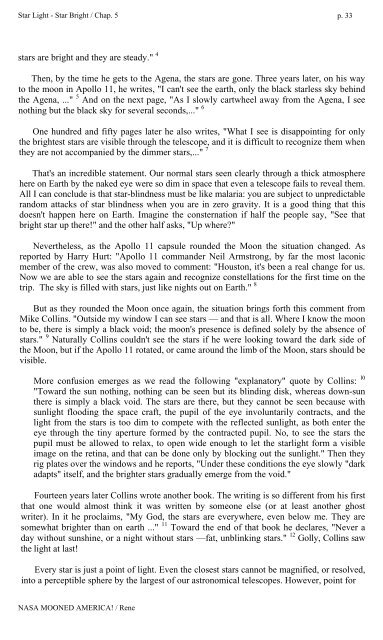Rene-NASA-Mooned-America
Rene-NASA-Mooned-America
Rene-NASA-Mooned-America
You also want an ePaper? Increase the reach of your titles
YUMPU automatically turns print PDFs into web optimized ePapers that Google loves.
Star Light - Star Bright / Chap. 5 p. 33<br />
stars are bright and they are steady." 4<br />
Then, by the time he gets to the Agena, the stars are gone. Three years later, on his way<br />
to the moon in Apollo 11, he writes, "I can't see the earth, only the black starless sky behind<br />
the Agena, ..." 5 And on the next page, "As I slowly cartwheel away from the Agena, I see<br />
nothing but the black sky for several seconds,..." 6<br />
One hundred and fifty pages later he also writes, "What I see is disappointing for only<br />
the brightest stars are visible through the telescope, and it is difficult to recognize them when<br />
they are not accompanied by the dimmer stars,..." 7<br />
That's an incredible statement. Our normal stars seen clearly through a thick atmosphere<br />
here on Earth by the naked eye were so dim in space that even a telescope fails to reveal them.<br />
All I can conclude is that star-blindness must be like malaria: you are subject to unpredictable<br />
random attacks of star blindness when you are in zero gravity. It is a good thing that this<br />
doesn't happen here on Earth. Imagine the consternation if half the people say, "See that<br />
bright star up there!" and the other half asks, "Up where"<br />
Nevertheless, as the Apollo 11 capsule rounded the Moon the situation changed. As<br />
reported by Harry Hurt: "Apollo 11 commander Neil Armstrong, by far the most laconic<br />
member of the crew, was also moved to comment: "Houston, it's been a real change for us.<br />
Now we are able to see the stars again and recognize constellations for the first time on the<br />
trip. The sky is filled with stars, just like nights out on Earth." 8<br />
But as they rounded the Moon once again, the situation brings forth this comment from<br />
Mike Collins. "Outside my window I can see stars — and that is all. Where I know the moon<br />
to be, there is simply a black void; the moon's presence is defined solely by the absence of<br />
stars." 9 Naturally Collins couldn't see the stars if he were looking toward the dark side of<br />
the Moon, but if the Apollo 11 rotated, or came around the limb of the Moon, stars should be<br />
visible.<br />
More confusion emerges as we read the following "explanatory" quote by Collins: l0<br />
"Toward the sun nothing, nothing can be seen but its blinding disk, whereas down-sun<br />
there is simply a black void. The stars are there, but they cannot be seen because with<br />
sunlight flooding the space craft, the pupil of the eye involuntarily contracts, and the<br />
light from the stars is too dim to compete with the reflected sunlight, as both enter the<br />
eye through the tiny aperture formed by the contracted pupil. No, to see the stars the<br />
pupil must be allowed to relax, to open wide enough to let the starlight form a visible<br />
image on the retina, and that can be done only by blocking out the sunlight." Then they<br />
rig plates over the windows and he reports, "Under these conditions the eye slowly "dark<br />
adapts" itself, and the brighter stars gradually emerge from the void."<br />
Fourteen years later Collins wrote another book. The writing is so different from his first<br />
that one would almost think it was written by someone else (or at least another ghost<br />
writer). In it he proclaims, "My God, the stars are everywhere, even below me. They are<br />
somewhat brighter than on earth ..." 11 Toward the end of that book he declares, "Never a<br />
day without sunshine, or a night without stars —fat, unblinking stars." 12 Golly, Collins saw<br />
the light at last!<br />
Every star is just a point of light. Even the closest stars cannot be magnified, or resolved,<br />
into a perceptible sphere by the largest of our astronomical telescopes. However, point for<br />
<strong>NASA</strong> MOONED AMERICA! / <strong>Rene</strong>


